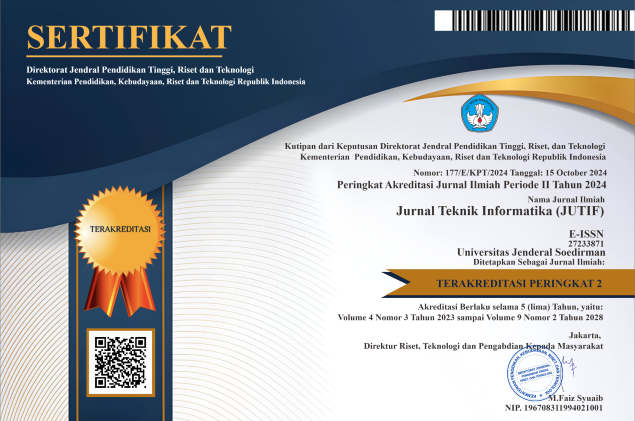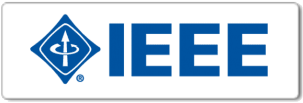Evaluating Software Quality in a Point of Sales System in a Fast-Food Restaurant Using the McCall Model
DOI:
https://doi.org/10.52436/1.jutif.2025.6.4.4860Keywords:
McCall Model, Point of Sales (POS), Product Operation, Software QualityAbstract
Software quality is an critical aspect in ensuring system performance and user satisfaction. This study evaluates the quality of the system called Sampos. is a system used by internal employees in managing fast food business operations for record transactions. manage raw material stocks and help track daily reports. The evaluation was conducted using the McCall model, which focuses on five primary quality factors: correctness, reliability, efficiency, integrity, and usability. Each factor is assessed through indicators that reflect the system's performance in that aspect. The measurement stage begins by assigning weights to each indicator based on its level of importance. Then. The quality value of each factor is calculated to get a comprehensive picture of system performance. The results of the evaluation showed that the correctness value was 56.2%, reliability 56%, Integrity 47.8%, and usability 46%, which are generally classified as "Pretty Good.". Meanwhile, the value of the efficiency factor is only 38.2%, so it is categorized as "not good." Overall, the Sampos system obtained an average score of 41% - 60%. This indicates that the system requires improvement, especially in the aspect of efficiency. This study contributes to proving that McCall's method can be used to evaluate applications built without documentation and by a single developer. Therefore, this study contributes a practical case study on the application of McCall’s Model as an effective method for identifying and quantifying quality weakness in small-scale operational systems.
Downloads
References
Y. Yang, F. Si, J. Tan, G. Liu, and Y. Zhang, “User experience evaluation methods and models for software products,” vol. 125062, p. 234, Dec. 2022, doi: 10.1117/12.2662541.
A. Abiyoga, W. Witanti, and A. K. Ningsih, “Pengukuran Kualitas Perangkat Lunak Menggunakan Model McCall Pada Sistem Akademik Universitas Jenderal Achmad Yani,” INDEX, vol. 3, no. 2, pp. 69–74, Nov. 2021, doi: 10.36423/index.v3i2.877.
I. Prayanthi, E. Lompoliu, and R. L. Klabat, “THE EFFECT OF SYSTEM QUALITY, INFORMATION QUALITY AND PERCEIVED USEFULNESS ON ACCOUNTING INFORMATION SYSTEM USER SATISFACTION,” Accounting Review |, vol. 1, no. 2, pp. 1–11, Sep. 2020, doi: https://doi.org/10.60090/kar.v1i2.475.1-11.
Ian. Sommerville, Software Engineering. Pearson, 2016.
B. Respiar, A. Fernanda, F. Maulana, and A. Halim Anshor, “Peran Penting Software Quality Assurance Dalam Pengembangan Aplikasi,” Journal Scientific of Mandalika (jsm) e-ISSN, vol. 5, no. 12, pp. 2809–0543, 2024, doi: https://doi.org/10.36312/10.36312/vol5iss12pp535-540.
Y. Thamilarasan, R. R. R. Ikram, M. Osman, and L. Salahuddin, “A Review on Software Quality Models for Learning Management Systems,” Journal of Advanced Research in Applied Sciences and Engineering Technology, vol. 32, no. 2, pp. 203–221, Oct. 2023, doi: 10.37934/ARASET.32.2.203221.
D. Rajapaksha, C. Tantithamthavorn, J. Jiarpakdee, C. Bergmeir, J. Grundy, and W. Buntine, “SQAPlanner: Generating Data-Informed Software Quality Improvement Plans,” IEEE Transactions on Software Engineering, vol. 48, no. 8, pp. 2814–2835, Aug. 2022, doi: 10.1109/TSE.2021.3070559.
H. Tanuwijaya and A. B. Tjandrarini, “Analisis Kualitas Production Planning Information System Menggunakan McCall’s Framework,” JEMSI, vol. 5, no. 3, pp. 232–239, Jan. 2024, doi: 10.31933/jemsi.v5i3.
S. Yadav, “Analysis and Assessment of Existing Software Quality Models to Predict the Reliability of Component-Based Software,” International Journal of Emerging Trends in Engineering Research, vol. 8, no. 6, pp. 2824–2840, Jun. 2020, doi: 10.30534/ijeter/2020/96862020.
E. Peters and G. K. Aggrey, “An ISO 25010 based quality model for ERP systems,” Advances in Science, Technology and Engineering Systems, vol. 5, no. 2, pp. 578–583, Apr. 2020, doi: 10.25046/aj050272.
M. Falco and G. Robiolo, “Building a catalogue of ISO/IEC 25010 quality measures applied in an industrial context,” in Journal of Physics: Conference Series, IOP Publishing Ltd, Mar. 2021. doi: 10.1088/1742-6596/1828/1/012077.
M. Tuape, V. Hasheela-Mufeti, A. Kayanda, and J. Kasurinen, “Software Development in Small Software Companies: Exploring the Usage of Procedures, Techniques, Methods and Models in Practice,” ACM International Conference Proceeding Series, pp. 29–38, Nov. 2021, doi: 10.1145/3501774.3501779.
Roger S. Pressman, Software Engineering: A Practitioner’s Approach, Seventh edition. 2010. [Online]. Available: www.mhhe.com/pressman.
Daniel Galin, Software Quality Concepts and Practice. 2018.
L. R. Kalankesh, Z. Nasiry, R. Fein, and S. Damanabi, “Factors Influencing User Satisfaction with Information Systems: A Systematic Review,” Galen Medical Journal, vol. 9, no. 1686, pp. 1–9, Jun. 2020, doi: 10.31661/gmj.v9i0.1686.
M. Akbari and U. Hayati, “PENGUKURAN KUALITAS SISTEM ELECTRONIC CUSTOMER RELATIONSHIP MANAGEMENT PADA BENGKEL USAHA JAYA MOTOR MENGGUNAKAN METODE MCCALL,” Jurnal Mahasiswa Teknik Informatika, vol. 6, no. 2, pp. 673–678, Sep. 2022, doi: https://doi.org/10.36040/jati.v6i2.
Hanes, Angela, and Salsalina, “Pengukuran Kualitas Website Penjualan Tiket Dengan Menggunakan Metode MCCALL,” Jurnal Teknik Informatika Kaputama (JTIK), vol. 4, no. 2, p. 81, Jul. 2020, doi: https://doi.org/10.35870/jtik.v4i2.
A. M. Suhari Camara, K. Aelani, and F. S. Dwi Juniar, “Pengujian Kualitas Website menggunakan Metode McCall Software Quality (Studi Kasus smkn4bdg.sch.id),” vol. 03, no. 1, pp. 25–32, 2021, doi: https://doi.org/10.37253/joint.v3i1.
Y. Andriyani et al., “IMPLEMENTASI MCCALL’S FRAMEWORK DALAM PENGUJIAN KUALITAS PERANGKAT LUNAK (STUDI KASUS PORTAL KULIAH KERJA NYATA UNIVERSITAS RIAU),” Jurnal Teknik Informatika, vol. 13, no. 2, pp. 201–212, Oct. 2020, doi: https://doi.org/10.15408/jti.v13i2.16986.
A. Farisi, R. Teguh, and R. Lestari, “Analisis Kualitas Sistem Informasi Haji Terpadu Menggunakan Metode McCall,” vol. 7, no. 2, pp. 83–92, 2022, doi: https://doi.org/10.31328/jointecs.v7i2.
Donald R. Coooper and Pamela S. Schindler, Business research Methods, Twelfth Edition. 2014.
S. A. Saputera, D. Sunardi, A. Syafrizal, and P. Samsidi, “EVALUASI SISTEM INFORMASI AKADEMIK MENGGUNAKAN METODE MCCALL,” JTIS, vol. 3, no. 2, pp. 38–45, Jul. 2020, doi: 10.36085/jtis.v3i2.878.
P. B. Lestari, D. Hafidh Zulfikar, and C. E. Gunawan, “Analisis Kualitas Sistem Informasi Data Pemilih (SIDALIH) Menggunakan Model McCall,” JUSIFO (Jurnal Sistem Informasi), vol. 6, pp. 1–14, Jun. 2020, doi: https://doi.org/10.19109/jusifo.v6i1.5526.
K. Z. Khairul, E. Rianti, F. Yenila, and T. Pradana, “Analisis Kualitas Sistem Informasi Absensi Karyawan dengan Metode McCall,” Jurnal KomtekInfo, vol. 10, no. 3, pp. 93–100, Sep. 2023, doi: 10.35134/komtekinfo.v10i3.417.
E. Pujianto, N. Suryana, L. Kusumawati, M. Model, and W. Usability, “IMPLEMENTATION OF ANALYSIS OF THE MC CALL MODEL ON THE WEBSITE OF LUBUKLINGGAU CITY LIBRARY AND ARCHIVES SERVICE,” vol. 1, no. 1, pp. 1–8, Jun. 2023, doi: https://doi.org/10.31848/jesii.v1i1.
M. Andini and G. F. Fitriana, “Analisis Kualitas Aplikasi Simpel Pol Menggunakan Metode McCall,” JURIKOM (Jurnal Riset Komputer), vol. 9, no. 3, p. 680, Jun. 2022, doi: 10.30865/jurikom.v9i3.4192.
Additional Files
Published
How to Cite
Issue
Section
License
Copyright (c) 2025 Wahyu Fidi Ramadhina Assidiq, Fidi Wincoko Putro, Arni Muarifah Amri

This work is licensed under a Creative Commons Attribution 4.0 International License.



























